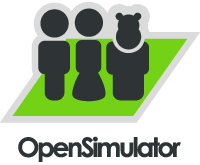The open source movement allowed complex avatar-based, game-engine software to become available free of charge using OpenSimulator. Contributions from artists and designers now makes pre-developed virtual artifacts and design spaces available to educators, meeting planners, and game designers; easy modifications and adjustments allow for custom virtual environments for an infinity of purposes.
Server rental companies, such as Kitely, are now making it possible to have up to 40 avatars at any time on up to 4 virtual islands for $20 per month; and, you can put a virtual island on your own institutional server (for free, sort-of). This link brings you to a theory-and-practice based resource on outlines education uses and possibilities with these environments that have been used by its author for over 10 years in her own teaching.
Here’s a student during the creative learning/practice stage in a course where she is at the beginning stage of creating an eventual meeting space for music teachers so they can work in a comfortable and travel-free professional-development space to improve their craft as K12 music educators.
OpenSimulator
Keywords: 3D, Collaboration, Media, Simulations, Virtual Labs, Virtual Reality (VR)


 (+2 rating, 2 votes)
(+2 rating, 2 votes)